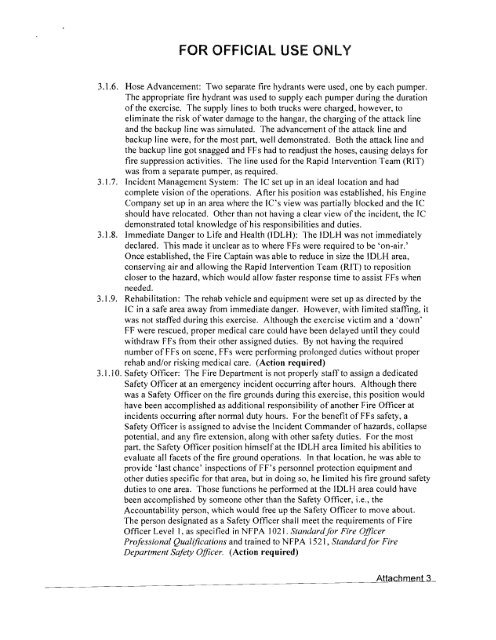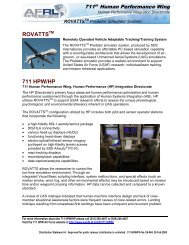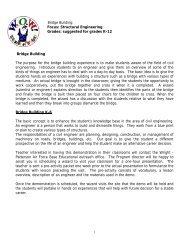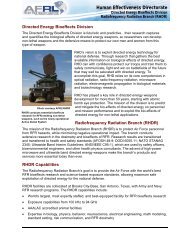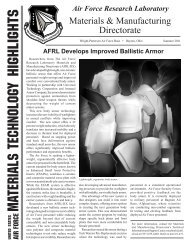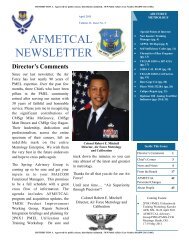Plant 44 Audit Reports - Wright-Patterson Air Force Base
Plant 44 Audit Reports - Wright-Patterson Air Force Base
Plant 44 Audit Reports - Wright-Patterson Air Force Base
- No tags were found...
You also want an ePaper? Increase the reach of your titles
YUMPU automatically turns print PDFs into web optimized ePapers that Google loves.
FOR OFFICIAL USE ONLY3.1.6. Hose Advancement: Two separate fire hydrants were used, one by each pumper.The appropriate fire hydrant was used to supply each pumper during the durationofthe exercise. The supply lines to both trucks were charged, however, toeliminate the risk ofwater damage to the hangar, the charging of the attack lineand the backup line was simulated. The advancement ofthe attack line andbackup line were, for the most part, well demonstrated. Both the attack line andthe backup line got snagged and FFs had to readjust the hoses, causing delays forfire suppression activities. The line used for the Rapid Intervention Team (RIT)was from a separate pumper, as required.3.1.7. Incident Management System: The IC set up in an ideal location and hadcomplete vision of the operations. After his position was established, his EngineCompany set up in an area where the lC's view was partially blocked and the ICshould have relocated. Other than not having a clear view of the incident, the ICdemonstrated total knowledge of his responsibilities and duties.3.1.8. Immediate Danger to Life and Health (JDLH): The IDLH was not immediatelydeclared. This made it unclear as to where FFs were required to be 'on-air.'Once established, the Fire Captain was able to reduce in size the IDLH area,conserving air and alIowing the Rapid Intervention Team (RIT) to repositioncloser to the hazard, which would allow faster response time to assist FFs whenneeded.3.1.9. Rehabilitation: The rehab vehicle and equipment were set up as directed by theIe in a safe area away from immediate danger. However, with limited staffing, itwas not staffed during this exercise. Although the exercise victim and a 'down'FF were rescued, proper medical care could have been delayed until they couldwithdraw FFs from their other assigned duties. By not having the requirednumber of FFs on scene, FFs were performing prolonged duties without properrehab and/or risking medical care. (Action required)3.1.1 O. Safety Officer: The Fire Department is not properly staff to assign a dedicatedSafety Officer at an emergency incident occurring after hours. Although therewas a Safety Officer on the fire grounds during this exercise, this position wouldhave been accomplished as additional responsibility of another Fire Officer atincidents occurring after normal duty hours. For the benefit of FFs safety, aSafety Officer is assigned to advise the Incident Commander of hazards, collapsepotential, and any fire extension, along with other safety duties. For the mostpart, the Safety Officer position himselfat the IDLH area limited his abilities toevaluate all facets ofthe fire ground operations. In that location, he was able toprovide 'last chance' inspections of FF's personnel protection equipment andother duties specific for that area, but in doing so, he limited his fire ground safetyduties to one area. Those functions he performed at the IDLH area could havebeen accomplished by someone other than the Safety Officer, i.e., theAccountability person, which would free up the Safety Officer to move about.The person designated as a Safety Officer shall meet the requirements of FireOfficer Level I, as specified in NFPA 1021. Standardfor Fire OfficerProfessional Qualifications and trained to NFPA 1521, Standardfor FireDepartment Safety Officer. (Action required)Attachment 3


